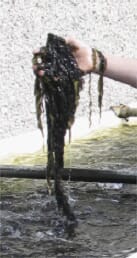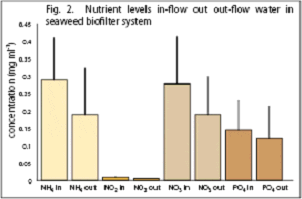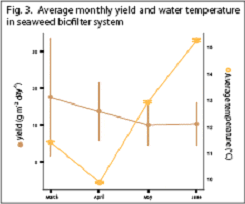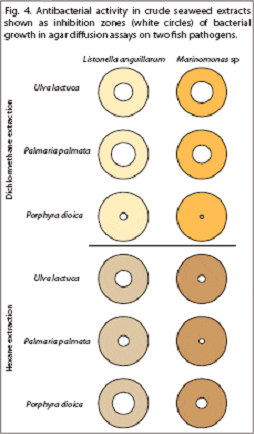
However, Macroalgae - that is seaweeds - are capable of absorbing these excess nutrients, and producing a natural and often very useful and valuable biomass.
A research project within the European Aquareg programme has found significant benefits in using seaweed as a biological filter in aquaculture operations.
Aquareg is an EU-funded regional framework project and part of the European INTERREG initiative. It focuses on peripheral regions of the European community, primarily three key areas: the Western Coast of Ireland, Galicia in Spain and Trondelag in Norway. The programme links fisheries businesses and research, education projects and coastal resource management and environmental issues through co-operative projects and collaboration.
"It's a matter of pooling resources for mutual benefits," said Dr Dave Jackson of the Marine Institute, Galway, Ireland which has links with the initiative. Speaking to the FishSite during Aqua Nor 2007, he said that the projects within Aquareg have proved extremely beneficial. "These regions face similar challenges and we can learn by co-operating with one another," he added.

The algae/biofilter study has been evaluating the capabilities of seaweed to reduce the environmental impact of different Irish aquaculture facilities. The findings have implications for aquaculture businesses in the other EU peripheral regions and worldwide - seaweed in aquaculture has significant environmental advantages.
Integrated benefits


The effluent water from ponds with fin-fish is fed into tanks where unattached seaweeds are maintained. These seaweeds act as integral biofilters. By cultivating macroalgae (seaweed) in the effluent tanks the nutrient pollution from aquaculture systems can be alleviated. In addition, the macroalgae can be harvested to produce another value-added product offering fish enterprises another economic incentive to improve environmental management.
The strategy has many benefits. Seaweed is an excellent Abalone and Urchin feed, it has valuable pigments and it utilises vast amounts of nutrients from the effluent which it converts efficiently into biomass. However, there are potential problems too, such as the loss of tissue with the onset of reproduction, it is seasonal and it is also temperature sensitive, which reduces nutrient absorption rates.
The maximum potential of the biofilter was assessed by screening the seaweeds for potential antibacterial activity. Some 13 of 29 recent investigations have used Ulva as the experimental seaweed in integrated systems. The only commercial scale seaweed-based integrated fish and abalone farm in operation uses Ulva as a biofilters to remove nutrients from the water and also as feed for the Abalone. However, other algae may be more suitable, both as biofilters and as a value-added secondary product.
The red alga Porphyra has also been used in trials and proved successful. Initial results from Irish land-based aquaculture sites have shown that Porphyra can remove excess nutrients from the tanks. A significant reduction in ammonia, phosphate and nitrate was also achieved in the initial four-month trial (Fig. 2). It produced considerable seaweed yields in the initial weeks of the trial, but this decreased as the temperature increased (Fig. 3). Also, all crude extracts inhibited bacterial growth of fish pathogens (Fig. 4). A slightly higher activity was observed for dichlormethane than hexane extracts of Ulva and Palmaria, but not for Porphyra for which hexane extraction gave the highest inhibition activity (3-6 mm vs. 1-2 mm).
Conclusions
The species of Porphyra used, P. dioica, is a high-intertidal alga that is present throughout the year, although most abundant in the field in late winter to early spring. This species was suitable as a biofilter, under Irish conditions, and a consistent harvest of biomass was also obtained, although yield dropped as temperatures increased. This species may not be the most suitable during the summer or in warmer climates. Trials are now underway using the green alga, Ulva lactuca, a species which has been used extensively in other integrated-aquaculture trials. The potential benefits of other species, for example Palmaria palmata, are also being considered. Antibiotic activity has been observed in both Ulva and Porphyra, but how these levels change seasonally in field and tank-cultured thalli is undergoing further investigation.
Cascading tank system
A cascading tank system (6m² - 3m² - 1m² surface area) is supplied with UV-treated effluent water from the fin-fish hatchery at Martin Ryan Institute, Carna (Fig. 1). Seaweed tanks were stocked with field collected Porphyra at a density of ~0.5 kg m-³. Thalli were kept in motion by vigorous aeration. Biomass was removed from the tanks weekly and the wet weight measured. Tanks were restocked at the original stocking density after measurement. Water temperature and light intensity were continuously monitored using in-situ dataloggers
Antibacterial activity of biofilter species
Bacterial inhibition was evaluated as growth inhibition of specific test bacteria by the agar diffusion method. Two bacteria isolated from diseased cod juveniles; Listonella anguillarum (HI610) and Marinomonas sp. were used. Sterile 6 mm paper discs were treated with 2 x 25 ?l of seaweed-extract or solvent (negative control) and allowed to dry between each addition. Discs were then applied to agar plates seeded with 100 ?l of a known bacterial culture and incubated (20°C). Inhibition zones (radius from discs in mm) were registered after 24 hours.
The study was carried out by: Stefan Kraan, Ingrid Salvesen & Robert Wilkes at the Irish Seaweed Centre the Martin Ryan Institute, National University of Ireland, Galway, Ireland; and SINTEF Fisheries and Aquaculture, Bioresources, Trondheim, Norway.
Further Reading
|
|
- You can view the full research report by clicking here. |
September 2007

